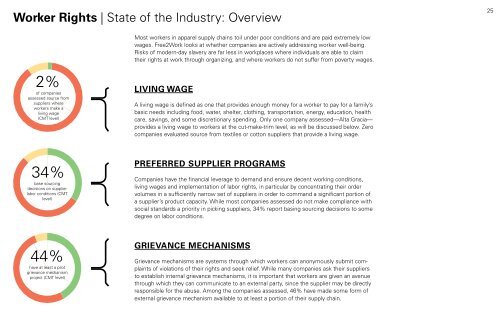APPAREL INDUSTRY TRENDS - Free2Work
APPAREL INDUSTRY TRENDS - Free2Work
APPAREL INDUSTRY TRENDS - Free2Work
You also want an ePaper? Increase the reach of your titles
YUMPU automatically turns print PDFs into web optimized ePapers that Google loves.
Worker Rights | State of the Industry: Overview<br />
2%<br />
of companies<br />
assessed source from<br />
suppliers where<br />
workers make a<br />
living wage<br />
(CMT level)<br />
34%<br />
base sourcing<br />
decisions on supplier<br />
labor conditions (CMT<br />
level)<br />
44%<br />
have at least a pilot<br />
grievance mechanism<br />
project (CMT level)<br />
Most workers in apparel supply chains toil under poor conditions and are paid extremely low<br />
wages. <strong>Free2Work</strong> looks at whether companies are actively addressing worker well-being.<br />
Risks of modern-day slavery are far less in workplaces where individuals are able to claim<br />
their rights at work through organizing, and where workers do not suffer from poverty wages.<br />
LIVING WAGE<br />
A living wage is defined as one that provides enough money for a worker to pay for a family’s<br />
basic needs including food, water, shelter, clothing, transportation, energy, education, health<br />
care, savings, and some discretionary spending. Only one company assessed—Alta Gracia—<br />
provides a living wage to workers at the cut-make-trim level, as will be discussed below. Zero<br />
companies evaluated source from textiles or cotton suppliers that provide a living wage.<br />
PREFERRED SUPPLIER PROGRAMS<br />
Companies have the financial leverage to demand and ensure decent working conditions,<br />
living wages and implementation of labor rights, in particular by concentrating their order<br />
volumes in a sufficiently narrow set of suppliers in order to command a significant portion of<br />
a supplier’s product capacity. While most companies assessed do not make compliance with<br />
social standards a priority in picking suppliers, 34% report basing sourcing decisions to some<br />
degree on labor conditions.<br />
GRIEVANCE MECHANISMS<br />
Grievance mechanisms are systems through which workers can anonymously submit complaints<br />
of violations of their rights and seek relief. While many companies ask their suppliers<br />
to establish internal grievance mechanisms, it is important that workers are given an avenue<br />
through which they can communicate to an external party, since the supplier may be directly<br />
responsible for the abuse. Among the companies assessed, 46% have made some form of<br />
external grievance mechanism available to at least a portion of their supply chain.<br />
25


